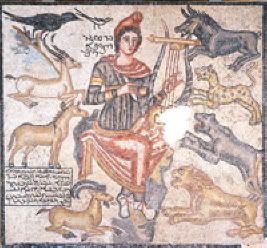Mosaic is one of the great art forms of the ancient Mediterranean world. Beginning in the fourth century B.C., wealthy Greek houses and tombs were decorated with scenes comprised of pebbles in cement mortar. Like much of Greek art, mosaics remained popular in the Roman Empire. The floor mosaic, Orpheus Taming Wild Animals, is an excellent example not only of the painterly tradition, but also of the relevance of mythology within Roman culture.
The scene of Orpheus taming wild animals with the sound of music was and is a well-known story. Art historians think the popularity of Orpheus is probably related to the mystery cult, in which Orpheus is a savior figure with suggestions of immortality, like Dionysus. According to arguably one of the most famous myths featuring Orpheus was his attempt to bring his wife, Eurydice, back to life from Hades. Orpheus managed to convince the guard with his music to allow Eurydice back to Earth. This was only permitted under the condition Orpheus does not look back. Otherwise, his wife would be lost forever. Famously, Orpheus did look back and he lost Eurydice. In another myth detailing his demise, Orpheus was torn to pieces by maenads, but his severed head floated down the river, still singing, suggesting his power over life and death.
The inscription next to Orpheuss head, written in Aramaic, says, Son of Zagrios, the player, is playing. The inscription near the bottom translates to In the month of Nijan, year of five hundred and five, I Papa, son of Papa, made for myself (this) house of rest (), for myself, and for my children and for my heirs. Blessed is he who sees (it) and pronounces a blessing. The referral to house really means a tomb, or house of eternity. It is no wonder then that Orpheus was the chosen subject matter. The motif of Orpheus is often associated with mystery cults, the underworld and the land of the dead.
More than likely, this floor mosaic was commissioned by the owner of the tomb and he wanted something symbolic, combining myth and reality. As the myth of Orpheus was a popular motif, it is no wonder this scene was featured. However, what is exquisite is that the artist took a well-known story utilizing widely available marble created a work of art that graced the floor of the dead. The amount of time and planning spent does not compare to the fact that this motif was created not to be seen by the viewing public, but instead by those who were to begin their journey to the underworld.
Powered by Qumana


the mosaic of which you write [if i am not greatly mistaken] is that owned by the dallas museum of art–and which is currently a featured work in the current exhibit, ‘all the world’s a stage’. thank you for the translation to which i can refer researchers. john anderson, dallas area tour guide